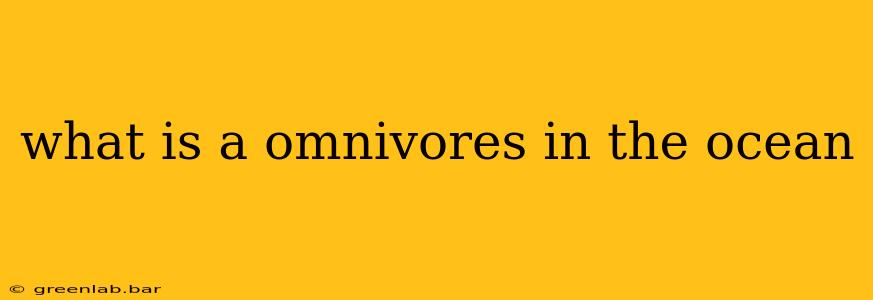The ocean's vastness teems with a breathtaking array of life, and within this biodiversity lies a fascinating group of animals known as marine omnivores. Unlike strict carnivores or herbivores, these creatures enjoy a varied diet, consuming both plants and animals. Understanding their role in the marine ecosystem is crucial to appreciating the intricate web of life beneath the waves.
Defining Marine Omnivores: A Dietary Balancing Act
Marine omnivores occupy a crucial niche in the ocean's food web. Their diet typically includes a mix of phytoplankton, zooplankton, algae, and various small animals. This dietary flexibility allows them to adapt to changing environmental conditions and resource availability. Their feeding habits often depend on factors like their life stage, the season, and the specific location within their habitat.
Examples of Common Marine Omnivores: A Diverse Group
The world of marine omnivores is incredibly diverse, showcasing the remarkable adaptability of life in the ocean. Here are some notable examples:
1. Sea Turtles: A Grazer's Tale
Several sea turtle species are considered omnivores. While their diets vary by species and age, they often consume seagrass, algae, jellyfish, sponges, and crustaceans. Green sea turtles, for example, are primarily herbivorous as adults, but juveniles may exhibit more omnivorous tendencies.
2. Many Fish Species: Adapting to Abundant Resources
A surprising number of fish species exhibit omnivorous behaviors. Examples include certain species of wrasses, gobies, and parrotfish. These fish may graze on algae during the day and then supplement their diet with small invertebrates at night. Their adaptability contributes to their success in various marine environments.
3. Crabs and Lobsters: Scavengers and Opportunists
Many crab and lobster species are opportunistic omnivores. They readily consume algae and other plant matter but also actively hunt smaller animals, scavenging for dead organisms when opportunities arise. This dietary flexibility allows them to thrive in diverse habitats.
4. Seabirds: Coastal Omnivores
Certain seabirds, particularly those inhabiting coastal regions, also demonstrate omnivorous characteristics. Their diets often include fish, crustaceans, and marine invertebrates, but they may also consume seaweed or other plant matter depending on availability.
The Ecological Importance of Marine Omnivores: Maintaining Balance
Marine omnivores play a vital role in maintaining the health and balance of marine ecosystems. Their consumption of both plants and animals helps regulate populations of both producers (plants) and consumers (animals), preventing imbalances that could disrupt the delicate equilibrium of the food web. Their diverse feeding strategies contribute to the overall biodiversity and resilience of marine communities.
Conclusion: Unveiling the Secrets of Ocean Omnivores
Marine omnivores are a fascinating and diverse group of organisms, showcasing the remarkable adaptability of life in the ocean. By studying their dietary habits and ecological roles, we can gain a deeper understanding of the intricate relationships that underpin the health and stability of marine ecosystems. Further research on these creatures continues to unveil their significance in maintaining the balance of the ocean's complex food web.

